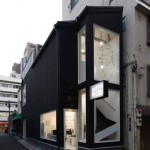両国国技館Ryogoku Kokugikan

Photo: François Rejeté / CC BY 2.0
Loud grunts, the rhythmic slapping of flesh, a quick dash, sweaty bodies brought close together. Two faces meet, staring at each other intensely, deeply in the eyes, their arms locked in a strong grip日本の国技である大相撲は、江戸時代から興行が始まったとされる歴史のある競技で、古くから続く日本の代表的な伝統文化のひとつ。その大相撲の興行のためにある日本一の施設が両国国技館だ。大相撲のイメージが強いがボクシングなどの試合に使用されることもある。
![]()
最初の旧両国国技館は1906年に建設。日本銀行本店や東京駅を設計した辰野金吾と葛西萬司がデザインしたもので、「大鉄傘」との愛称で親しまれた。しかし1917年に火事にて全焼。1920年に再建されたが、僅か3年後の1923年、関東大震災により外観を残したものの再度焼失。その後も戦争などで災害に遭い、場所を移しながらも相撲を興行し、1984年に旧両国貨物駅跡地に現在の新両国国技館が建設された。
![]()
現在の両国国技館は、地上2階、地下1階、緑の広い屋根が目立った迫力ある風格。近年大相撲の人気の低迷も懸念されているが、両国国技館を目で楽しみに行くと共に、一度は実際に大相撲観戦するのもいいのではないだろうか。
![]()
両国国技館
住所:東京都墨田区横網1-3-28
TEL:03-3623-5111(財団法人日本相撲協会)
http://www.kokugikan.co.jp
![]()
Text: Bonnie Oeni
Translation: Asami Miyamura – before they pull apart again.
![]()
Sumo’s not quite the same dance of love, but brings the same amount of surprise and suspense that comes with this traditional game of human stamina, perseverance and spirit strongly connected to the Japanese way of life. On the surface, it sounds simple – two wrestlers come together in an aim to force their opponent out of the wrestling ring, about 4.55m in diameter, or to throw him off balance such than his body parts, apart from his feet, come into contact with the playing surface. According to the Sumo Association, there are about 70 methods of beating your opponent, with common ones including the overarm throw and underarm throw. Opponents may use their open hand to trip or slap, but that’s it. Unlike other more brutal forms of wrestling, which might not prohibit eye-gouging, hair-pulling or hitting your opponent with a closed fist the way sumo does, sumo emphasises victory through sheer willpower, self-control and the true weight of your determination and desire.
![]()
One of the most exciting things about this sport is the fact that it doesn’t come with a weight class, which often pits the Rikishi (competitors) against a much heavier, more intimidating opponent. In a hierarchical sport that strongly emphasises ranking from the Yokozuna (Grand Champions) at the top, the victory of an underdog which assures his move up one class is often met with much excitement and astonishment. Since only the wrestlers in the top two divisions, Makuuchi and Juryo are paid a monthly salary, wrestlers literally have to clench their teeth and fight their way up to the top in order to assure his own income and fame. This is also because the Yokozuna are never demoted on the expectation that they can deliver consistent winning records. The very essence of the game itself then, is a traditional reflection of the disciplined work ethic in Japanese society, where you have to work your way to success at the pinnacle, starting with a transformation of the self. With its all-encompassing principles that dictate everything from costume to hair styles, rituals and strict dietary guidelines, sumo wrestling is certainly not for the weak-willed.
![]()
As an important cultural tradition that has survived the erosion of time, sumo goes beyond the sport itself – enshrining its Shinto-linked history in much pomp and extravagance. At the start of each tournament, everyone involved in the match wears vibrantly designed attire, and interwoven into the fabric is a narrative of traditions and meanings that hark all the way back to the Edo period. The Yokozuna don luxurious silk aprons sometimes worth over 500,000 yen, enter the ring and gather in a circle to perform the dohyo-iri (entrance procession), clapping hands and striking ritualistic poses, which is imitated by the lower-ranked sumatori when they leave the ring.
![]()
Before the match begins, the two Rikishi strip down to their mawashi, a belt made of cloth that, when unrolled, measures about 9m. They enter the dohyo, an elevated and sanctified platform created from clay and sand, where the ring is marked out with half-buried bales of straw. As a tribute to its Shinto roots, a wooden roof resembling the roof of Shinto shrines is also suspended above the ring.
![]()
Unravelling further chapters of the long narrative of culture they are a part of, the chiri-chozu ceremony is performed to show that they are not hiding any weapons and are ready to fight fair and square. At this time, at opposite ends of the ring, both wrestlers stretch out their arms and clap their hands once, before launching into the Shiko where they stamp their feet repeatedly and toss salt into the ring to purify it. Striding up to a white line, they crouch down, balling their fists, and glare at each other to try and break each other’s focus. During the 4-minute time limit given to these glare-offs, the Rikishi may attack at any time, and often a match lasts nothing more than a few seconds before the stronger, defter opponent executes a finishing blow and tosses, pushes or slaps in some way that causes his rival to lose balance or get thrown out of the ring.
![]()
Although sumo seems an atypical sport, with meandering rituals and customs that uphold Japanese traditions not seen in modern times anymore, it is this very emphasis on merging sport and culture and not keeping the two separate which gives the viewer an immersive, bewitching peek into what life might have been like in ancient Japan. With its emphasis on ritualistic meaning, sumo is a fascinating, combined experience of entertainment and education, which above all highlights the unyieldingness of the human will. Continuing to draw new fans from all over the world, with the competitors participating in matches not only in Japan, but even in Europe, North America and Britain, sumo has proven to be timeless and its legacy will be assured for a longer time yet.
![]()
One of the most popular sumo arena is Ryogoku Kokugikan, which was built specially for sumo tournaments. The hall is sometimes used for boxing match. Built in 1906, the old Ryogoku Kokugikan was designed by Kingo Tatsuno and Manji Kasai, who were known for their design for the head office of Bank of Japan and Tokyo Station. Even though the arena was rebuilt in 1920 as it was burnt down with an fire in 1917, the arena again burnt out with the Great Kanto Earthquake. The current Ryogoku Kokugikan was constructed in 1984 at the former site of the old Ryogoku Kamotsu station.
![]()
With 2 stories above ground and an underground stories, it stands stately with a green roof. Even the popularity of the sumo tournament declining, it is worth to enjoy both the Japanese traditional sumo and Ryogoku Kokugikan.
![]()
Ryogoku Kokugikan
Address: 1-3-28 Yokozuna, Sumida-ku, Tokyo
Tel: 03-3623-5111 (Nihon Sumo Kyokai)
http://www.sumo.or.jp
![]()
Text: Bonnie Oeni两国国技馆
地址:東京都墨田区横網1-3-28
电话:03-3623-5111
http://www.kokugikan.co.jp
![]()


